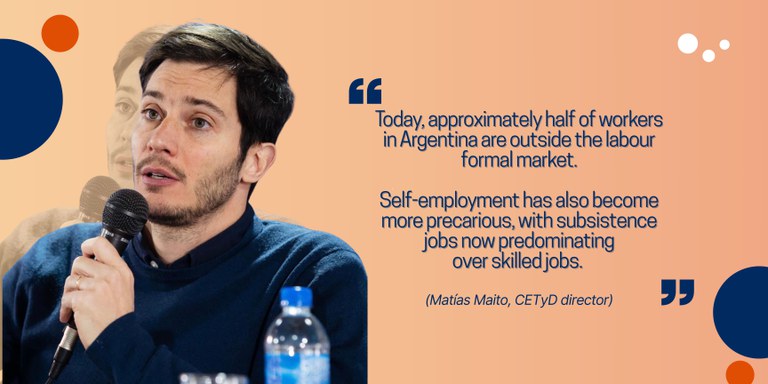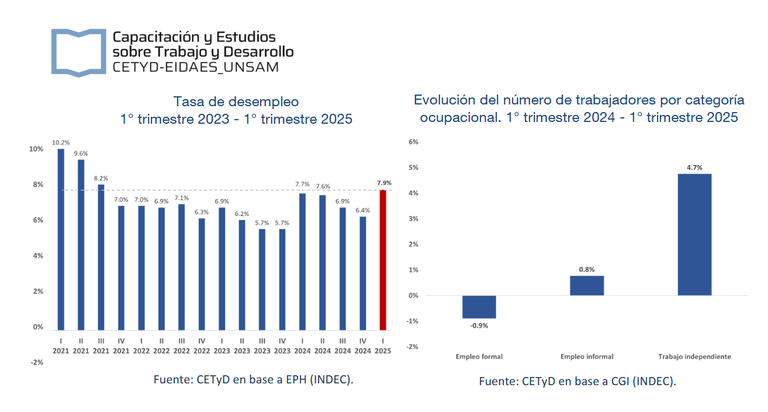
What is the current employment situation in Argentina?
The current employment situation in Argentina is complex, experiencing a worrying phenomenon of a contraction in formal employment (in both the public and private sectors), increasing job insecurity, and a decline in purchasing power.
CETyD's (Training and Studies Programme on Work and Development) latest report shows how the platform economy is becoming a quick and accessible alternative for earning income.
The document ¿Crece el refugio en el trabajo en plataformas? describes how the current context is driving many workers to seek additional sources of income.
To gain a deeper understanding of this phenomenon, WageIndicator interviewed Matías Maito, a labour market and labour institution analyst and CETyD director.
How have things changed in the employment sector in Argentina over time?
Matías Maito: “In the last 10 or 15 years, following the 2001 crisis, there was a decade of
sustained and rapid growth in formal employment, during which all indicators of deterioration were reversed in a sustained and marked manner. However, since 2012, economic activity has fluctuated greatly, and this has had logical consequences for the labour market.”
Maito also adds that “Today, approximately half of workers in our country are outside the labour formal market. Of those, two-thirds are in registered private employment and one-third in public employment. The other half are outside formal employment, either because they work in informal jobs (i.e., they have a boss who pays them ‘under the table,’ outside the law) or because they are self-employed. The problem is that self-employment has also deteriorated because it is not skilled and professional jobs that have become increasingly prevalent within self-employment, but precarious and subsistence jobs.”
“Self-employment has also become more precarious, with subsistence jobs now predominating over skilled jobs. Even the formal sector has experienced a significant deterioration in job quality and wages. The purchasing power of formal private-sector workers fell by between 15 and 20% between 2017 and 2019, a loss that has not yet been recovered.”

What about the unemployment rate? What does this indicator tell us?
According to Maito, the unemployment rate is no longer the most accurate indicator of the state of the labour market.
“Although it is growing, it has not reached historic crisis levels (it does not exceed 20%, as in 2001). Instead, other indicators are more alarming, such as high levels of informality, low incomes, and the growth of multiple job holding.”
What other phenomena are redefining work in Argentina?
Firstly, more people are holding multiple jobs. This trend, whereby individuals require more than one job to make ends meet, has grown by 50% over the past decade, rising from 8% to 12% of the workforce. Previously associated with specific sectors, such as teaching, it is now being observed in sectors where it was previously unheard of, such as industry. Although it accelerated during the pandemic, it is a pre-existing trend linked to macroeconomic deterioration.
Secondly, there is the 'additional worker' effect. When family income is insufficient, more household members (e.g. children or unemployed parents) are forced to start looking for work earlier than expected. This puts greater pressure on a labour market with limited capacity to respond, leading most people to take on precarious, temporary jobs or join the ranks of the unemployed.
Then there is platform work. However, “although digital platforms are considered a 'safety net', they do not have the capacity to absorb the high demand for work.”
As Maito explains, “the growth of the platform business is not keeping pace with the number of workers joining it, resulting in income per worker being diluted. To earn the same income as before, a driver, for example, would need to work longer hours (12–14 hours instead of 8–10).”
What does the future hold for workers in Argentina?
“The current development model, which focuses on activities such as mining and oil production that generate few jobs, coupled with government cutbacks and poor performance in labour-intensive sectors such as industry and construction, does not bode well for robust employment growth,” says Maito.
'In mid-2024, economic activity began to recover, but employment remained stagnant. Activity fell, then recovered, but employment continued to stagnate. So, there has been a sustained disconnect between what is happening with activity and employment.
In that context, even if activity leaves behind the current uncertainty and recovers, I do not believe employment will recover. It may grow slightly more than it is growing now, but it will neither return to its initial level nor enter a period of sustained growth.”
Is platform work a solution for Argentinians?
The outlook is not encouraging. “The problem with platform work, which is a refuge for those who cannot find better opportunities, is that demand has grown, but the business is not expanding at the same rate, and the market is finite”
There are not enough platforms to employ the millions who are already in precarious situations or unemployed, nor the thousands who join their ranks every month.
The growing phenomenon of people turning to the platform economy as a last resort highlights stagnating formal employment, job insecurity and the need to hold down multiple jobs to make ends meet. However, this solution also has its limits: what initially provides shelter will soon be insufficient in a market that cannot continue to grow.
The interview with Matías Maito is also available in Spanish.
Would you like to find out more about work and gig work in Latin America? Read on!
- The Price of Staying Online: How Connectivity Costs Impact Platform Workers in Latin America
- From Gadgets to Gear: Tracking Price Changes for Bolivia's Gig Workers
- Living Tariff: Rethinking Fair Compensation for the Self-Employed
